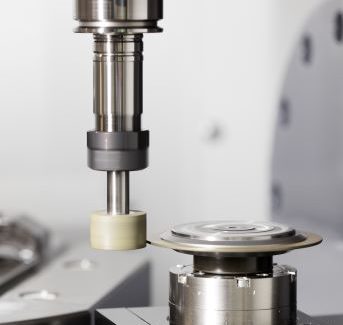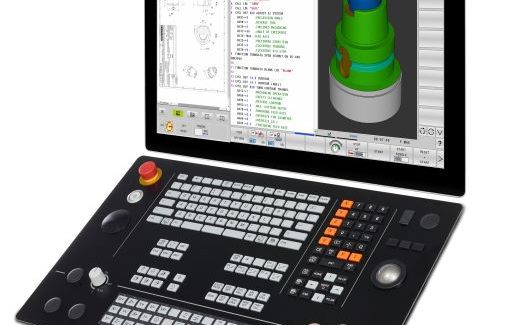The Benefits of Jig Grinding with 5-Axis Machining
Machine shops will remain competitive by utilizing jig grinding on a 5-axis machining center to produce complex parts that require milling and grinding surfaces. In addition to ROI, manufacturers will achieve better accuracy and productivity, among other advantages.
Posted: July 18, 2021
SURFACE CONDITIONING
By Gisbert Ledvon
A little history on jig grinding as paraphrased from Wikipedia: Jig grinding technology was developed at the end of World War I and is used for grinding complex shapes and holes where the highest degrees of accuracy and finish are required.
The table positioning and spindles on a jig grinder machine provide highly accurate mechanics and are known to provide accuracies of 0.0001 inch or better (far better than what a standard milling machine offers). This technology is almost exclusively used by tool and die makers in the creation of jigs or precision holes in dies. The machine operates by a high-speed air spindle rotating a grinding bit. The air spindles are removable and interchangeable to achieve varying surface speeds. Some spindles are fixed speed (60,000 rpm), others are adjustable (30,000-50,000 rpm), and still others are extremely (instead of very) high speed (175,000 rpm). This is a very dedicated machine tool just focusing on high-speed grinding applications.
Now moving into the 21st century, the ability to combine this high-speed jig grinding process with simultaneous 5-axis machining has become a reality offering numerous benefits, specifically where high accuracies and superior surface finishes are required in machining hardened components made from steel like D2 or H13 commonly used in tool mold applications.
HIGH-SPEED MACHINING
As many know, some of today’s CNC machine tools already offer high-speed machining (HSM). With this, for example as available as HSC (High-Speed Cutting) on a HEIDENHAIN TNC 640 mill-turn motion control, machining surface finish quality down to RA0.15 µm (if PCD tools are used) is possible, otherwise surface finishes of RA <0.4 µm are achievable using high quality solid carbide cutting tools.
Just to be clear, I consider a machine high speed when it is equipped with at least a 30,000-rpm spindle. Ideally, a high-speed machine should be equipped with a 40,000+ rpm spindle and be able to accelerate/decelerate with 1G (32.17 ft/s2 or 9.81 m/s2), which requires a mechanically high precision design including a closed loop linear encoder. Specifically, this high precision closed loop system would consist of “glass scales” for the linear axes X-Y-Z and a direct-rotary measuring system on all the rotary axes A-B-C. If the machine is not equipped with this technology, achieving high-speed part accuracy on a 3D surface or pitch within a few microns is nearly impossible and certainly cannot be achieved in a “first part perfect fit” application.
WHAT IS CLOSED LOOP?
Closed loop control boosts workpiece accuracy because it eliminates thermal error. Thermal error is the main cause of position error on modern machine tools, mainly arising from the machining process itself. Significant error may result if the thermal expansion and contraction of machine components is not compensated for in the process. Conventional control loops, however, are unable to detect thermal changes in the feed mechanism. Closed loop control is therefore recommended for enabling dimensional and contour accuracy in everything from one-off parts to large-batch production.
The capability of a machine tool to cope with rapidly changing operating conditions is a decisive factor for its accuracy. A transition from roughing to finishing completely changes the mechanical and thermal load on the machine, which can cause considerable changes in accuracy. Similar load changes occur during machining of smaller production runs. Permanent changes between setup processes and order-specific machining cause varying heat inputs with the corresponding effects on accuracy.
The dimensional accuracy of finished parts depends on the individual machines and sub processes of the entire production system. Linear encoders in closed loop configurations help increase the machining accuracy. Greater tolerance reserves, for example, can then be used to deploy tools for longer periods.
This type of motion design technology guarantees perfect engagement of the cutting tool with the part and a consistent chip load in the cutting process. This also extends tool life by maintaining maximum cutting speeds and part accuracy. All critical to be able to control the highly accurate jig grinding process.
WHY COMBINE JIG GRINDING AND 5-AXIS MACHINING?
As we see, the mechanical offerings of an HSC/HSM machine and a jig grinding machine are similar, so why would jig grinding even make sense on a 5-axis machine? Here are a few reasons:
1. Cost Efficiency
This new combination allows machining of hard-material parts more cost efficiently because expensive tools are no longer required. For example, a machinist can now machine a carbide part without the need for expensive PCD cutting tools because grinding tools are less expensive in general and can be redressed several times without replacing them. This combination also eliminates the common need for outsourcing of the jig grinding process.
2. Better Accuracy and Productivity
Machining a part with both technologies in one set up improves accuracy and productivity. No re-clamping or re-indicating of the part is now necessary, which improves feature and pitch accuracy as well as setup time. The part stays on one machine and does not have to be transferred to another.
3. Allows Creation of Functional Surfaces
Some features on the same part require functional surfaces that cannot be machined with the HSM/HSC process and require a grinding pattern. These patterns help lubricants to stick better on the steel surface, specifically on punches in tool and die applications. If using a 5-axis machine equipped with jig grinding, this can now be done at the touch of a few buttons on one machine control.
4. Avoids Tool Deflection
The inherent nature of this new combination avoids tool deflection on small diameter tools < 5 mm because the grinding tool does not deflect as much as a milling cutter because the grinding forces are much less. This helps with avoiding tool deflection in deep narrow cavities and eliminates tapers on straight walls thus eliminating rework or hand polishing on critical surfaces.
5. Higher Process Accuracy
Due to wheel dressing right in the 5-axis machine, redressing the grinding tool (< 1 µm accuracy) between processes always provides a fresh tool for the next process, ensuring a reliable and accurate process.
6. Better ROI
By taking full advantage of all the jig grinding options on a 5-axis machining center already in the shop, the user’s return on investment is significant as it has thus eliminated the need to purchase a dedicated jig-grinding machine. The 5-axis machining center can run unattended overnight combining both technologies in a reliable process producing completely finished parts.
All these reasons to use jig grinding on a 5-axis machining center will help manufacturers who produce complex parts that require milling and grinding surfaces stay competitive. By taking full advantage of their 5-axis machining center investment by incorporating a jig grinding feature, manufacturers can minimize setup times and achieve higher utilization rates, keeping the spindle turning and making chips and money. Also controlling the entire manufacturing process in house adds value for their customers by providing them a one-stop solution.
For those who already have or are interested in HEIDENHAIN’s TNC 640 mill-turn control on their machining center, which is always a part of a closed loop motion control system, this is a simple option using the relevant milling cycle with an incorporated jig grinding tool. We are here to answer any questions you may have and support your efforts.

















